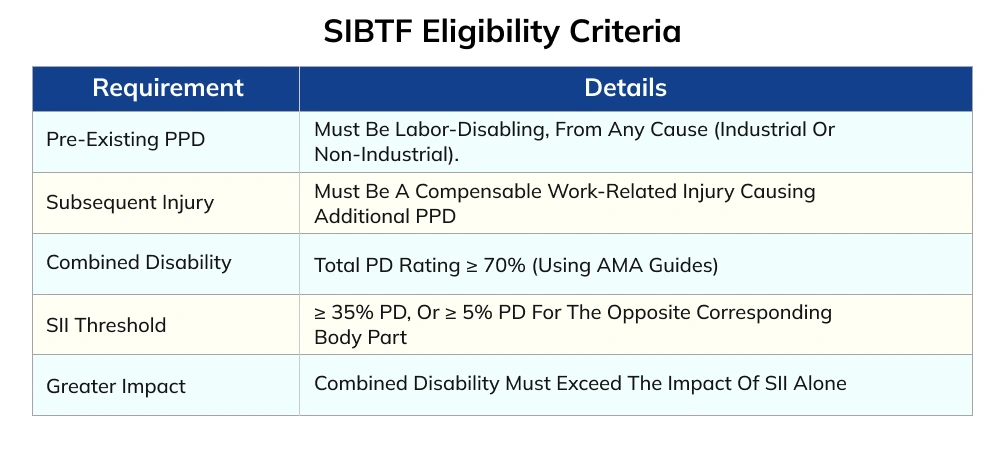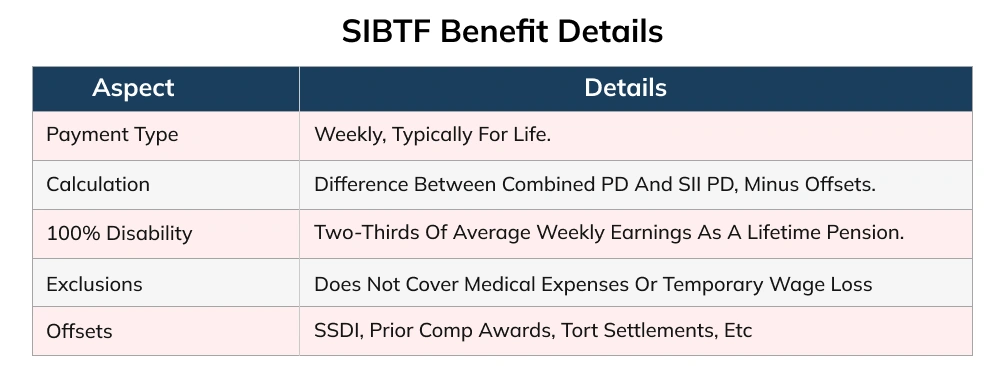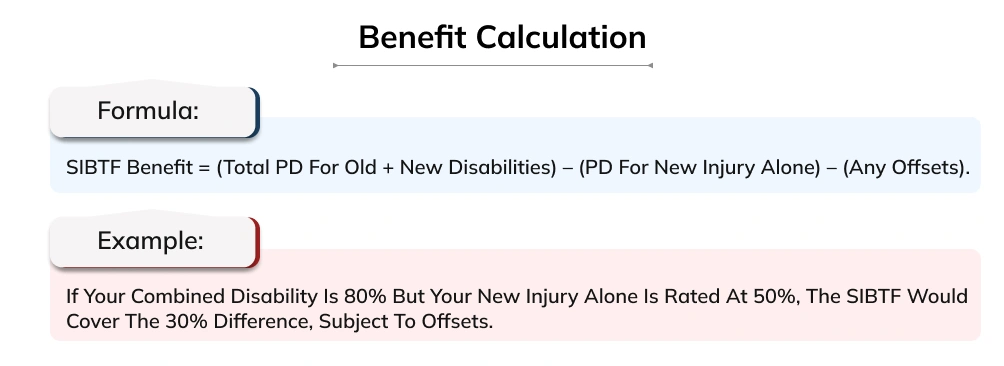Hey there, I’m Joe Pluta. If you’re already living with a ratable permanent disability in California, and you suffer a new, work‑related injury, the state’s Subsequent Injury Benefit Trust Fund (SIBTF) might just have your back when no one else will.
Here’s the deal:
- To qualify, your pre-existing impairment must already have an official rating (typically established by a Qualified Medical Evaluator).
- Then, if a compensable workplace injury pushes your combined permanent disability to 70% or more, or meets the opposite-limb rule (35% pre-existing + 5% new), you may be eligible for supplemental weekly payments.
- These payments stack on top of your current workers’ comp benefits and, depending on your impairment rating, can result in substantial long-term compensation.
This post will walk you through what SIBTF actually is, who qualifies, and how to make a strong claim without getting lost in legal red tape.
What Is SIBTF and Why Does It Matter?
The Subsequent Injury Benefit Trust Fund (SIBTF) is California’s best-kept secret for injured workers who have pre-existing conditions . Created in 1945 following World War II to encourage employers to hire disabled veterans, this state-supervised trust fund provides additional compensation when a workplace injury combines with a pre-existing disability to create severe impairment.
The SIBTF meaning goes beyond simple workers’ compensation – it’s designed to ensure that workers with disabilities aren’t penalized in the job market while providing them with fair compensation when subsequent injuries occur. The fund operates on a simple principle: you shouldn’t have to choose between employment and adequate compensation for combined disabilities.
Understanding California Labor Code 4751: Your Legal Foundation
According to California Labor Code Section 4751, the SIBTF supplements workers’ comp benefits for workers with a qualifying pre-existing disability who suffer a second workplace injury that significantly increases their permanent impairment.
The law requires that the degree of disability caused by the combination of both disabilities must be greater than what would have resulted from the subsequent injury alone, with the combined effect equaling 70 percent or more of total disability. This legal framework ensures that workers receive compensation commensurate with their overall impairment level.
Who Qualifies for SIBTF Benefits? The Five Essential Criteria
To qualify for SIBTF, you must have a permanent disability from a prior condition, one that’s officially rated, even if it wasn’t work-related. If your new workplace injury leads to a combined permanent impairment of 70% or more, or your injuries affect opposite limbs (like one arm before, one leg now) with at least 35% pre-existing and 5% new, then you may be eligible. The fund only kicks in when that combined effect is substantially greater than the most recent injury alone.

1. The Pre-Existing Permanent Partial Disability Requirement (PPD)
To qualify for SIBTF benefits, you must have a pre-existing permanent disability that was labor-disabling at the time of your subsequent workplace injury. This disability can be either industrial or non-industrial in origin, meaning it could stem from a previous work injury, car accident, birth defect, or medical condition.
The pre-existing condition must have been ratable as permanent partial disability, even if it was never formally rated. Examples include arthritis, vision impairment, heart conditions, diabetes, or previous injuries to limbs.
2. The Subsequent Industrial Injury Requirement (SII)
Your workplace injury must be compensable under workers’ compensation law and result in additional permanent partial disability. This subsequent injury can affect any part of your body and doesn’t need to involve the same area as your pre-existing condition.
3. The Combined Disability Threshold
The most critical requirement is that your combined disabilities must total at least 70% permanent disability. This calculation considers both your pre-existing condition and your workplace injury using the American Medical Association (AMA) Guides to Impairment, 5th Edition.
4. Meeting the Percentage Thresholds
Your case must satisfy one of two pathways :
a. The 35% Threshold:
Your subsequent workplace injury alone causes 35% or more permanent disability.
b. The 5% Opposite and Corresponding Threshold:
If your pre-existing disability affects a hand, arm, foot, leg, or eye, and your workplace injury affects the opposite corresponding body part with at least 5% disability .
5. The Greater Impact Requirement
The combination of both disabilities must create a more significant impairment than the subsequent injury would have caused alone. This ensures the fund only applies when the pre-existing condition truly compounds the workplace injury’s impact.
How Does the SIBTF Process Work?
1. Filing Your Application
The SIBTF process begins with filing an Application for Benefits with the Workers’ Compensation Appeals Board. This same court system that handles your workers’ compensation case has jurisdiction over SIBTF claims. You can obtain the application form online through the Division of Workers’ Compensation website.
2. Medical Evaluation Requirements
Unlike standard workers’ compensation evaluations, SIBTF cases require specialized medical reporting. You don’t have to use the same doctors from your workers’ compensation case – in fact, obtaining evaluations from physicians experienced with SIBTF issues is often beneficial .
The SIBTF pays for these medical evaluations regardless of whether your claim is ultimately approved . One must have a ratable disability, typically confirmed by a Qualified or Agreed Medical Evaluator (QME or AME)
3. Documentation and Evidence Gathering
Success in SIBTF cases depends heavily on comprehensive documentation. You’ll need:
- Complete medical records showing your pre-existing condition
- All documentation from your workplace injury
- Medical evaluations calculating your combined disability rating
- Evidence that your pre-existing condition was labor-disabling
- Proof that the combined effect exceeds what the workplace injury would have caused alone
What Are SIBTF Benefits Worth?

Lifetime Compensation Structure
SIBTF benefits provide lifetime weekly payments based on your combined disability percentage and earnings. If you’re found to be 100% disabled, you receive 66% of your average weekly earnings – the same rate as temporary disability payments.
For disability ratings between 70% and 99%, there’s a sliding scale with payments increasing as the disability percentage rises . A successful claim can result in hundreds of thousands of dollars in lifetime benefits.
One successful case resulted in an injured worker receiving $139,880.54 in back pay and $516.43 per week for life with cost-of-living increases . This demonstrates the substantial financial impact a successful SIBTF claim can have on an injured worker’s life.
Payment Calculation and Reductions
The SIBTF provides compensation “for the remainder of the combined permanent disability existing after the last injury”. However, this amount may be reduced by compensation received for the pre-existing disability, with certain exceptions.

Why Do Most Workers Miss Out on SIBTF Benefits?
Lack of Awareness Among Attorneys
Many workers’ compensation attorneys don’t handle SIBTF cases due to their complexity. This specialized area requires deep knowledge of disability calculations, medical evaluation procedures, and the intricate legal requirements.
Complex Legal Requirements
The intersection of pre-existing conditions, workplace injuries, and disability calculations creates a complex legal landscape that requires specialized expertise . Understanding when the 5% opposite and corresponding rule applies versus the 35% threshold requires careful analysis.
Time-Sensitive Nature
SIBTF applications must be filed while your workers’ compensation case is active or shortly thereafter. Missing these deadlines can result in permanent loss of benefits worth hundreds of thousands of dollars.
Common SIBTF Scenarios: Could You Qualify?
1. The Construction Worker’s Story
A construction worker with pre-existing arthritis in his left knee (rated at 15% disability) suffers a workplace injury to his right knee, resulting in 10% disability. The combined 25% disability doesn’t meet the 70% threshold, but the opposite and corresponding rule applies since both injuries affect corresponding body parts, and the workplace injury exceeds 5%.
2. The Office Worker’s Case
An office worker with diabetes and heart conditions (combined 40% pre-existing disability) suffers a workplace back injury, resulting in 35% disability. The combined 75% disability exceeds the 70% threshold, and the workplace injury meets the 35% requirement, making this a strong SIBTF case.
3. The Healthcare Worker’s Situation
A healthcare worker with pre-existing depression and anxiety (20% disability) develops work-related PTSD (30% disability). Combined with additional stress-related physical symptoms, the total disability could exceed 70%, potentially qualifying for SIBTF benefits.
Avoiding Common SIBTF Pitfalls
1. Incomplete Medical Documentation
Many potential SIBTF cases fail due to inadequate medical documentation. It’s crucial to provide detailed information about all pre-existing conditions, including those that might seem unrelated to your workplace injury.
2. Misunderstanding the Opposite and Corresponding Rule
The 5% threshold only applies when specific body parts are involved and the injuries affect opposite corresponding members . Misapplying this rule can result in claim denial.
3. Timing Issues
Waiting too long to pursue SIBTF benefits can result in complications or missed deadlines. Early evaluation and filing are essential for success.
Conclusion: Don’t Leave Money on the Table
The Subsequent Injury Benefit Trust Fund represents a significant opportunity for injured workers with pre-existing conditions to receive fair compensation for their combined disabilities. However, the complex legal requirements and specialized knowledge needed to successfully navigate SIBTF cases mean that many eligible workers never receive these benefits.
If you’ve suffered a workplace injury and have any pre-existing health conditions, don’t assume you’re not eligible for SIBTF benefits. The potential for lifetime compensation worth hundreds of thousands of dollars makes it essential to have your case properly evaluated by an attorney experienced in SIBTF law.
Contact Joseph Pluta Attorney At Law, today for your free consultation. Don’t let complex legal requirements prevent you from receiving the compensation you deserve. Your financial future may depend on taking action now.
This article is for informational purposes only and does not constitute legal advice. Each case is unique, and qualification for SIBTF benefits depends on specific circumstances.









